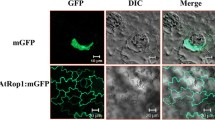Abstract
Transgenic tobacco (Nicotiana tabacum L.) plants constitutively expressing a rice (Oryza sativa L.) gene encoding a small GTPase, rgp1, showed marked resistance to tobacco mosaic virus (TMV) infection compared with the wild type [H. Sano et al. (1994) Proc Natl Acad Sci USA 91:10556–10560]. In order to examine the gene expression profile, the temperature-shift method was adopted to hyper-activate the N-gene inducing the hypersensitive response (HR), and transcripts of 11 representative HR genes were analyzed. In transgenic and wild-type plants, transcripts of 10 genes were induced during the HR; however, in most cases, their expression level was higher in the former than in the latter. Mock treatment of transgenic plants also efficiently induced transcripts of 8 out of 11 genes after temperature shift, indicating that their activation is mediated by the N-gene. Salicylic acid and its glucoside-conjugates were induced in both transgenic and wild-type plants, but their quantity in the former was unusually higher than in the latter. These results suggest that expression of rgp1 positively influenced the signaling pathway of the HR, resulting in higher induction of salicylates. This possibly caused a "priming effect" that hyper-activates the HR genes through the N-gene without TMV infection. It was thus conceivable that, despite a structural similarity to the Rab-family of GTPases, which function in membrane trafficking, rgp1 might participate in the signal transduction pathway of the HR.


Similar content being viewed by others
Abbreviations
- HR:
-
hypersensitive response
- SA:
-
salicylic acid
- SAG:
-
salicylic acid β-glucoside
- TMV:
-
tobacco mosaic virus
References
Aspuria ET, Anai T, Fujii N, Ueda T, Miyoshi M, Matsui M, Uchimiya H (1995) Phenotypic instability of transgenic tobacco plants and their progenies expressing Arabidopsis thaliana small GTP-binding protein genes. Mol Gen Genet 246:509–513
Chomczynski P, Sacchi N (1987) Single-step of RNA isolation by acid guanidinium thiocyanate–phenol–chloroform extraction. Anal Biochem 162:156–159
Conrath U, Pieterse CM, Mauch-Mani B (2002) Priming in plant–pathogen interactions. Trends Plant Sci 7:210–216
Hall A, Zerial M (1995) Overviews of the Ras superfamily of small GTPases. In: Zerial M, Huber LA (eds) Guidebook to the small GTPases. Oxford University Press, Oxford, pp 3–11
Inaba T, Nagano Y, Nagasaki T, Sasaki Y (2002) Distinct localization of two closely related Ypt3/Rab11 proteins on the trafficking pathway in higher plants. J Biol Chem 277:9183–9188
Kamada I, Yamauchi S, Youssefian S, Sano H (1992). Transgenic tobacco plants expressing rgp1, a gene encoding a ras-related GTP-binding protein from rice, show distinct morphological characteristics. Plant J 2:799–807
Kang J-G, Yun J, Kim DH, Chung KS, Fujioka S, Kim JI, Dae HW, Yoshida S, Takatsuto S, Song PS, Park CM (2001) Light and brassinosteroid signals are integrated via a dark-induced small G protein in etiolated seedling growth. Cell 105:625–636
Kohler A, Schwindling S, Conrath U (2002) Benzothiadiazole-induced priming for potentiated responses to pathogen infection, wounding, and infiltration of water into leaves requires the NPR1/NIM1 gene in Arabidopsis. Plant Physiol 128:1046–1056
Mur LA, Naylor G, Warner SA, Sugars JM, White RF, Draper J (1996) Salicylic acid potentiates defense gene expression in tissue exhibiting acquired resistance to pathogen attack. Plant J 9:559–571
Raskin I, Turner IM, Melander WR (1989) Regulation of heat production in the inflorescences of an Arum lily by endogenous salicylic acid. Proc Natl Acad Sci USA 86:2214–2218
Rutherford S, Moore I (2002) The Arabidopsis Rab GTPase family: another enigma variation. Curr Opin Plant Biol 5:518–528
Sano H, Ohashi Y (1995) Involvement of small GTP-binding proteins in defense signal-transduction pathways of higher plants. Proc Natl Acad Sci USA 92:4138–4144
Sano H, Youssefian S (1991) A novel ras-related rgp1 gene encoding a GTP-binding protein has reduced expression in 5-azacytidine-induced dwarf rice. Mol Gen Genet 228:227–232
Sano H, Seo S, Orudgev E, Youssefian S. Ishizuka K, Ohashi Y (1994) Expression of a small GTP-binding protein gene in tobacco plants elevates cytokinin levels and abnormally induces salicylic acid in response to wounding and increases resistance to tobacco mosaic virus infection. Proc Natl Acad Sci USA 91:10556–10560
Sano H. Seo S, Koizumi N, Niki T, Iwamura H, Ohashi Y (1996) Regulation by cytokinins of endogenous levels of jasmonic and salicylic acids in mechanically wounded tobacco plants. Plant Cell Physiol 37:762–769
Schumacher K, Vafeados D, McCarthy M, Sze H, Wilkins T, Chory J (1999) The Arabidopsis det3 mutant reveals a central role for the vacuolar H+-ATPase in plant growth and development. Genes Dev 13:3259–3270
Shirasu K, Nakajima H, Rajasekhar VK, Dixon R, Lamb C (1997) Salicylic acid potentiates an agonist-dependent gain control that pathogen signals in the activation of defense mechanisms. Plant Cell 9:261–270
Ueda T, Nakano A (2002) Vesicular traffic: an integral part of plant life. Curr Opin Plant Biol 5:513–517
Vernoud V, Horton AC, Yang Z, Nielsen E (2003) Analysis of the small GTPase gene superfamily of Arabidopsis. Plant Physiol 131:1191–1208
Yoda H, Ogawa M, Yamaguchi Y, Koizumi N, Sano H (2002) Identification of early responsive genes associated with the hypersensitive response and properties of a WRKY-type transcription factor in tobacco plants upon tobacco mosaic virus infection. Mol Genet Genom 267:154–161
Zimmerli L, Jakab G, Metraux JP, Mauch-Main B (2000) Potentiation of pathogen-specific defense mechanisms in Arabidopsis by β-aminobutyric acid. Proc Natl Acad Sci USA 97:12920–12925
Acknowledgements
The authors are grateful to Drs. N. Koizumi and Y. Yamaguchi (Nara Institute of Science and Technology) for valuable suggestions and discussion, and Dr. Malcolm A. Moore (Intermal, Nagoya) for critical reading of the manuscript. This work was supported by a grant from the Research for the Future Program (JSPS-RFTF00L01604) of the Japan Society for the Promotion of Science.
Author information
Authors and Affiliations
Corresponding author
Rights and permissions
About this article
Cite this article
Yoda, H., Sano, H. Activation of hypersensitive response genes in the absence of pathogens in transgenic tobacco plants expressing a rice small GTPase. Planta 217, 993–997 (2003). https://doi.org/10.1007/s00425-003-1092-6
Received:
Accepted:
Published:
Issue Date:
DOI: https://doi.org/10.1007/s00425-003-1092-6




